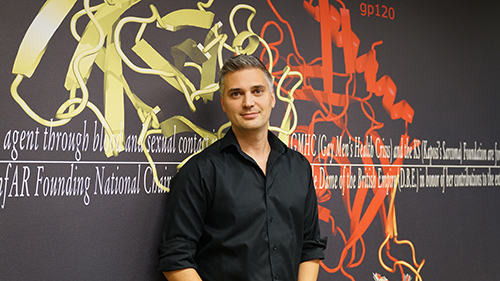Dr. Jonah Sacha is a researcher at the Vaccine & Gene Therapy Institute at Oregon Health & Science University in Portland. A previous amfAR grantee, Sacha and his lab team are studying stem cell transplantation in order to understand how Timothy Ray Brown was cured of HIV. Jonah recently spoke to amfAR about his interest in science, the early findings of his research, and his optimism about a cure.

Dr. Jonah Sacha at amfAR’s headquarters in New York City.
What first sparked your interest in science?
My stepbrother had muscular dystrophy. Watching him succumb to the disease slowly and eventually die really stuck with me. I was planning to become a doctor—I come from a family of physicians. But in high school, I passed out watching a surgeon perform a hip replacement. I realized medicine was not for me. I double majored in German and molecular biology at the University of Missouri. I went to graduate school with the intent of doing gene therapy and rotated through the laboratory of Dr. David Watkins, a preclinical HIV vaccine development lab. I worked on HIV-specific T cells. I fell in love with it and was hooked.
You were awarded an amfAR grant in 2013 to study the role ofgraft-versus-hostdisease (GVHD) in curing HIV. Can you explain your research?
We were trying to figure out what was responsible for Timothy Brown’s cure. [Brown was cured of HIV following a stem cell transplant for leukemia]. Was it the chemotherapy? The GVHD he developed? [GVHD is a medical complication that occurs when donor cells attack the recipient’s cells]. The donor’s rare CCR5 mutation conferring resistance to HIV? We looked at the contribution of GVHD on the size of the HIV reservoir versus other elements using Mauritian cynomolgus macaques [monkeys]. We now have this powerful model to isolate the variables and determine yes/no for each hypothesis.
Did you come to any conclusions?
Based on the data that we've gotten and what I've looked at, I think that what purged Brown’s HIV reservoir was this graft-versus-HIV reservoir effect [the donor T cells recognized and killed his HIV-infected cells]. We know in people with blood cancers who receive bone marrow transplants, what puts them in remission is the graft-versus-leukemia effect. The CCR5 mutation probably played a role to some degree, but I think the most important component was the graft-versus-HIV reservoir.
Why do you think it has been so hard for us to successfully replicate his cure?
One, he was on antiretroviral therapy (ART) for such a long time that his reservoir was probably small. He was also heterozygous for the CCR5-delta-32 mutation, meaning he inherited one ‘normal’ copy of the gene for CCR5 and one mutated copy, so his reservoir was probably more constrained. He stopped ART on the day of the transplant. Maybe that’s a key component that we have completely overlooked. His chemotherapy regimen also included some drugs that are no longer on the market. Perhaps that played a role. That’s why it’s so important to have a preclinical non-human primate model like the one we developed to test these hypotheses individually. Because if you can identify the mechanisms for cure, you at least have something to target.
I think that what purged Brown’s HIV reservoir was this graft-versus-HIV reservoir effect.You’re continuing your research with a grant from the National Institutes of Health. Could you provide us with an update?
We've done a total of three transplants with monkeys that are infected with SIV (the simian version of HIV). In the last case, the monkey had the transplant while still on ART while the virus was fully suppressed. We gave her a donor lymphocyte infusion [infusion of the donor monkey’s white blood cells] to the point where her immune system became 100% derived from the donor. Unfortunately, she developed GVHD and had to be euthanized. However, when we looked at her tissues we couldn't find the virus. There was nothing in the bone marrow, and in the lymph node tissues, there was a thousand-fold reduction in the amount of viral DNA.
How do you explain the findings?
It's the graft-versus-HIV-reservoir effect. Those cells come in and see the recipient’s immune system and attack the foreign cells, wiping them out. I think that's how you clear the HIV reservoir. It’s essentially gene therapy. You’re removing diseased cells and replacing them with healthy cells. Unfortunately, the donor cells also see things like the liver, the skin, and the lining of the gastrointestinal tract as foreign and attack them as well. GVHD kills people while graft-versus-leukemia or graft-versus-HIV reservoir is protective. The two are not really all that dissimilar, but no one really understands how to disentangle them. This is the holy grail of treatment.
Our goal at amfAR is to develop the scientific basis of a cure by 2020. How close are we?
We've gotten little inklings and clues that you can actually cure people of HIV or at least put them in remission. I prefer the word ‘remission’ rather than ‘cure.’ I’m confident that we will be able to achieve ART-free remission. We already have tools in our tool box like CRISPR [gene-editing]. Theoretically, it's possible to go in and cut HIV out of DNA. It's going to take a while to develop that, but I think we’ll get there. My focus is on curing a monkey by 2020, and my enthusiasm level for that is high.